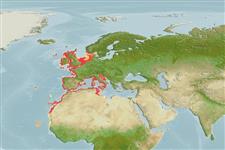Actinopterygii (ray-finned fishes) >
Atheriniformes (Silversides) >
Atherinidae (Silversides) > Atherininae
Etymology: Atherina: Greek, atherina, the Greek name for the eperlane; 1770 (Ref. 45335). More on author: Cuvier.
Environment / Climate / Range
Ecology
Marine; brackish; pelagic-neritic; oceanodromous (Ref. 51243). Subtropical, preferred 14°C (Ref. 107945); 60°N - 14°N, 26°W - 17°E
Eastern Atlantic: Kattegat (rare) and British Isles to Canary Islands, Mauritania and Cape Verde, also western Mediterranean.
Size / Weight / Age
Maturity: Lm ? range ? - ? cm
Max length : 20.0 cm TL male/unsexed; (Ref. 30578); max. reported age: 4 years (Ref. 232)
Dorsal
spines
(total): 7 - 9;
Dorsal
soft rays
(total): 114;
Anal
spines: 1;
Anal
soft rays: 14 - 17. Scales in longitudinal series 52-57. Vertebrae 46-52 (Morocco), 49-52 (the Netherlands). No pyloric appendages. A large, characteristic, brilliant silvery stripe running along flanks from head to tail, often outlined in black. No true lateral line (Ref. 232). Eye diameter same with snout length (Ref. 35388).
Small pelagic fishes in coastal areas and estuaries. Schooling, seasonal migrations in the Atlantic. Feeds on carnivorous small crustaceans and fish larvae (Ref. 5980). Reproduces in spring and summer (Ref. 30578).
Life cycle and mating behavior
Maturity | Reproduction | Spawning | Eggs | Fecundity | Larvae
Spawning occurs in midsummer in English Channel and North Sea.
Maugé, L.A., 1990. Atherinidae. p. 604-605. In J.C. Quero, J.C. Hureau, C. Karrer, A. Post and L. Saldanha (eds.) Check-list of the fishes of the eastern tropical Atlantic (CLOFETA). JNICT, Lisbon; SEI, Paris; and UNESCO, Paris. Vol. 2. (Ref. 4499)
IUCN Red List Status (Ref. 115185)
CITES (Ref. 94142)
Not Evaluated
Threat to humans
Harmless
Human uses
Fisheries: subsistence fisheries
Tools
Special reports
Download XML
Internet sources
